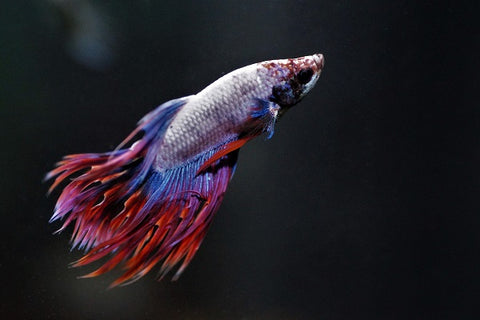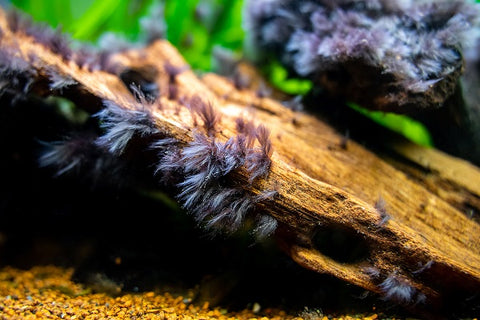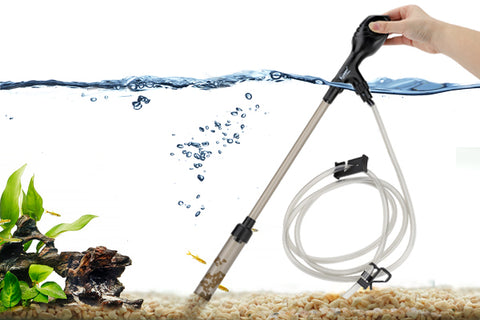Black beard algae are one of the things that aquarists wouldn’t like. It’s necessary to have fundamental techniques or ways to get rid of them.
Today’s article is going to be an interesting one because we will talk about the black beard algae in detail.
What are black beard algae in the aquarium?

Black beard algae are one type of algae that grow on the substrate of the aquarium. They grow especially in those tanks where the lights are too strong and the water is not clean. The tank should be kept clean to prevent black beard algae to grow.
Black beard algae also grow in dark places, like rocks and plants. Black beard algae get their name from the dark color and thin threads that look like a black beard.
In addition to their dark color, black beard algae are also distinguished by their high growth rate. It may grow up to 1-2 cm per day.
Important details about black beard algae
- They grow in almost all types of water conditions that are clear or murky.
- Black beard algae grow extremely fast but you can easily control it by preventing the entering of more light into the water and also reducing the fish population in the tank.
- They can't survive in conditions that are over-exposed to light for long hours.
- Abruptly environment changes will kill them because they don't adapt fast enough to the changes.
- Best environment for growth for black beard algae is at night time and they will become visible with the aid of lights.
- They do no harm to human body but may contain different types of toxic substances when eaten by fish.
Types of black beard algae
1. Oscillatoria
They are found in stagnant water and can be recognized by their thick black hair-like strands.
2. Stigeoclonium
They are very similar to Oscillatoria in all ways except the color. Stigeoclonium are more brownish than black and they don’t grow thick strands, instead preferring to grow in a thin layer.
3. Turbinaria
This type of black beard algae looks similar to Oscillatoria. The difference is that Oscillatoria are filamentous algae whileTurbinaria are colonial algae. You’ll have to look closely to tell them apart because they both produce whitish colonies that look like sand.
What are the possible causes of black beard algae?

The growth of black beard algae can be the result of an underlying problem with the aquarium water quality. For example, if the aquarium has too much light, CO2 levels are low or there are too many nutrients in the tank water, then black beard algae are likely to grow.
Excess nutrients will cause bad bacterial and algal blooms, which can quickly lead to severe water problems.
It is capable of growing on a wide range of surfaces including plants, gravel, decorations and rocks. They tend to form wherever there is little flow of water and plenty of light.
Prevention of black beard algae
Many aquarists are faced with the problem of algae growing in the aquarium, especially black beard. In spite of the fact that this type of algae can be seen for a long time, it is not always clear why it is formed in your aquarium.
Therefore, it is important to know how to prevent the spread of black beard algae in order to eliminate these problems as fast as possible and in a short time.
1. Mechanical method
Remove them manually by either pulling them out or cutting them out with scissors.
2. Remove the decorations
You may also need to remove the decorations from the tank if they are covered in black beard algae. Once you have removed as much as possible, you can use anti-fungal medicines to treat the remaining black beard algae.
3. Feeding properly
Properly feed your fish. Do not allow uneaten food to stay in the aquarium. In this way, you'll minimize the chance of these algae becoming a problem.
4. Regular tank maintenance
Regular water changes will reduce nutrient buildup and help to keep the aquarium system stable.
In order to fight against this parasite, you should clean the tank often (2 – 3 times a week). After each cleaning session, rinse it thoroughly with fresh water rather than leaving droplets of water in the tank, which will spread the black algae again.
5. Take measurements quickly once noticing
Because of its tendency to proliferate and especially because it appears very quickly (up to several days), you should act quickly if you wish to stop its development on your glass.
6. Use UV light
First of all, you need to ensure that the aquarium has the right light and water conditions to support the growth of this plant. Then, you just need to buy a good UV light and place it by the side of the tank. And finally, you can just switch it on and it will work in eradicating black beard algae from the tank.
7. Use hydrogen peroxide
You can use hydrogen peroxide for your aquarium if you don’t want black beard algae to grow. You need to use 10ml of 3% of hydrogen peroxide. Make sure that is evenly distributed to the whole tank.
8. Use flourish excel
It is a pesticide that is used in the agricultural industry. It is basically a CO2 liquid and is used as an alternative for CO2 injections.
9. Add algae eaters
Both Betta fish and the Otocinclus Catfish are great algae eaters. Introducing some algae eaters will help in cleaning your tank.

Some other fish that can eat black beard algae
- Chinese Algae Eater
- Cherry Barb
- Common Goldfish
- Black Molly
- Twig Catfish
- Bristlenose Pleco
- Rubber-Lipped Pleco
- Hillstream Loach
Are black algae good or bad for aquarium fish?

Black algae is usually black in color and will appear as dark patches on the fish’s body. Usually, the black or dark patches are on the fins, but if left untreated they will spread to the rest of the fish’s body.
Too much black beard algae in the aquarium will lead to a poor environment that will compromise the natural growth of the fish.
In some cases, the black beard algae will not harm the fish but provide a hiding space for fish. But it will damage the plants because it blocks the light that plants need for growth.
Conclusion
In the above article, we have discussed various things regarding back beard algae. We have talked in detail about the black beard algae's potential causes and the preventive measures. In addition, we mentioned some of the suitable ways for aquarists to remove them from the surface. We also listed some of the fish that will do good when it comes to eating black beard algae.
Hope you find this article helpful and share it with your aquarist friends. If you have any unanswered questions, please leave them in the comment section, we will try to help solve them.




Comments (0)
Back to Aquarium Maintenance